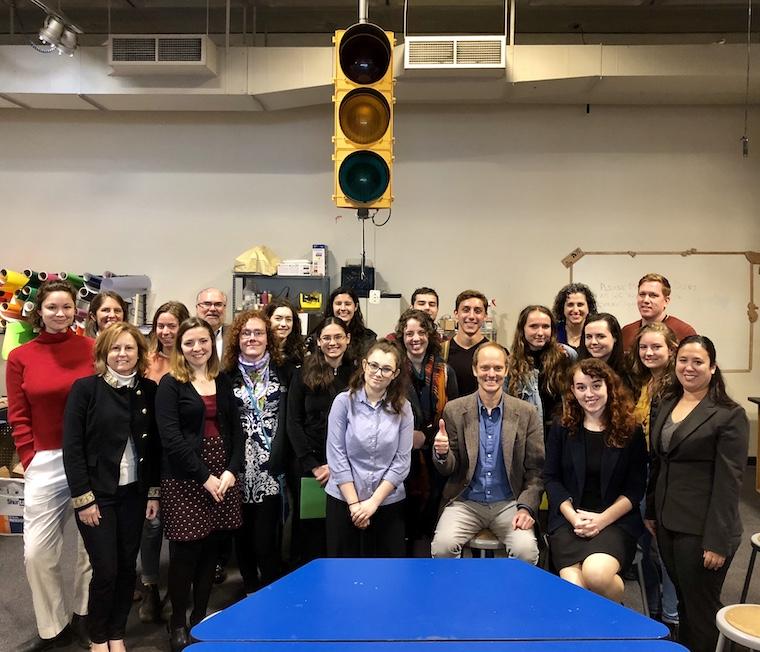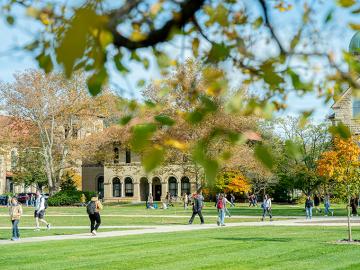Environmental Studies Students Key Players in Cleveland Foundation Grant
December 17, 2018
Erin Ulrich ’18

In August 2018, Oberlin College was awarded a $120,000 grant from the Cleveland Foundation to implement Environmental Dashboard technology at the Great Lakes Science Center (GLSC) and to incorporate real-time energy usage data from the Cleveland metro region.
The Oberlin College Environmental Dashboard team includes Norman D. Henderson Professor of Psychology and Environmental Studies Cindy Frantz, who is project evaluator; Associate Professor and Chair of Environmental Studies Rumi Shammin; energy and urban analysis coordinator; and Paul Sears Professor of Environmental Studies John Petersen, project director.
The project, which will take place through June 2020, heavily involves the work of students in Petersen’s fall 2018 Practicum in Environmental Communications course. Students in Petersen’s class are developing content for all three components of the Environmental Dashboard technology that will be installed at the GLSC.
Project groups are developing the Building Dashboard component, which communicates real-time energy usage data in the GLSC facility as well as developing Citywide Dashboard, an animated map of the Cleveland metro region displaying its environmental conditions. Students are also generating Community Voices, which combines images and text contributed by collaborators on the grant project, including the Cleveland Mayor’s Office of Environmental Sustainability, the Northeast Ohio Sewer and Water District, Cleveland Metroparks, the Cleveland 2030 District, and the Cleveland Water Alliance.
Students are also working with the GLSC staff to develop Dashboard-focused STEM curriculum for middle school students in Cleveland public schools.
There are currently 18 Environmental Dashboard monitors installed throughout the city of Oberlin, including in the public schools, campus buildings, city hall, local businesses, and the Oberlin Public Library.
Several components of the Dashboard technology pioneered at Oberlin have spread beyond the city itself. In 2015-2016, with grant funding from the Great Lakes College Association, Shammin led a project to install Dashboard at four other liberal arts colleges—Albion, Antioch, DePauw, and Hope. In 2015, in collaboration with Palmer Conservation Consulting, and funding from the State of Ohio, Building Dashboard technology was also installed in 42 Toledo public schools. Two years later, a pilot installation was implemented in six Cleveland Metropolitan School District schools.
To most Oberlin students, Building Dashboard is easily recognizable. Housed in bustling coffee shops, libraries, and the local grocery store, the monitors have become conspicuous components of the Oberlin landscape. Yet, what may be surprising to some is how integral Oberlin students have been to the project’s development and success.
“There’s no aspect of the dashboard project that students haven’t been involved in developing, implementing, and evaluating,” Petersen says.
And he’s right: Lucid Design, a data visualization firm created in 2004 by Oberlin alums Vladi Shunturov ’05, Gavin Platt ’06, Michael Murray ’03, and John Petersen (Class of 1988) first developed dashboard technology at Oberlin. Lucid was bought earlier this year by Acuity Lighting, a multinational company worth more than $4 billion, and now has monitoring and display systems installed in thousands of buildings across the United States and Canada.

Photo courtesy of John Petersen
While some students have gone on to build careers based on their work developing dashboard technology, for many, the most important part of the project is the perspective it provides. “It’s been great to gain context about Oberlin,” says junior Grace Bohlsen. “I didn’t feel like I had that perspective before this project, but it’s actually part of this course.”
Phoebe Von Conta, the only first-year student enrolled in the course, says, “this project has been helpful to my transition to Oberlin. I’ve been able to see the bigger scope of Oberlin and be so quickly immersed in the community I’ll be living in for the next four years.”
When Building Dashboard technology was first being developed in Oberlin in 2000, the Dashboard team had green buildings like the Adam Joseph Lewis Center for Environmental Studies (AJLC) in mind. At the time, Oberlin had a sophisticated green building, yet people couldn’t directly interface with the sustainability measures of the building itself.
“The challenge was that, in an ecologically responsible commercial building like the AJLC,” Petersen says, “monitoring and display technology can teach people about the innovative technologies, but visitors and even occupants can’t actually use this information to alter building performances.”
So, the question then became: how can environmental technology become meaningful to people, changing both thought and behavior? With this question in mind, Petersen and his team decided to apply the technology that had been developed for buildings like the AJLC to buildings where occupants have greater control over their environment—such as in residence halls.
“We created true feedback in the sense that students gain visibility into something they didn’t see before, but have control over,” he says. “The research we have done indicates that this information changes their thought and behavior—so it’s now a complete feedback cycle.”
As the immediate consequences of climate change pose a greater threat than previously understood, the work of faculty and students on Oberlin’s Dashboard team recognizes that, in order to change the world, we must first change the way we think.
In his course, Petersen says, “there’s so much for students to gain from a project that deeply engages them in community-based projects. Positive change in the world is always a collaborative process. What these students are doing with our community partners in Oberlin and in Cleveland, this is real-world work.”
Tags:
You may also like…
The Impact of Collective Action
March 27, 2025
How our work as a community helped us achieve carbon neutrality.
Oberlin’s Sustainable Infrastructure Program Reaches Major Milestone
December 4, 2024
Geothermal heating and cooling system comes online, supports Oberlin reaching 100 percent carbon neutrality by 2025.
Stitches to Startup
September 27, 2023
Andrea Muliawan recieved a grant that helped her turn a hobby into a budding business.


